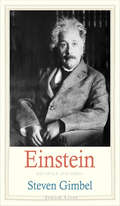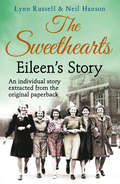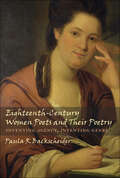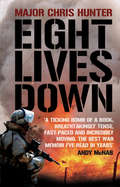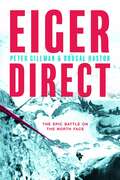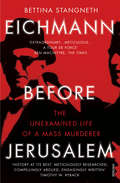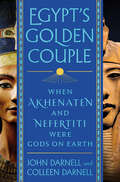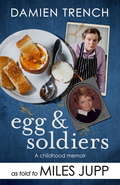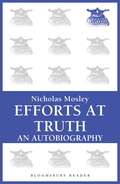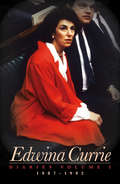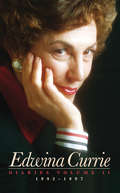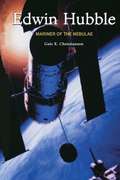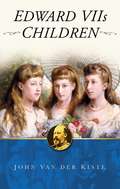- Table View
- List View
An Einstein Encyclopedia
by Alice Calaprice Daniel Kennefick Robert SchulmannThis is the single most complete guide to Albert Einstein's life and work for students, researchers, and browsers alike. Written by three leading Einstein scholars who draw on their combined wealth of expertise gained during their work on the Collected Papers of Albert Einstein, this authoritative and accessible reference features more than one hundred entries and is divided into three parts covering the personal, scientific, and public spheres of Einstein’s life.An Einstein Encyclopedia contains entries on Einstein’s birth and death, family and romantic relationships, honors and awards, educational institutions where he studied and worked, citizenships and immigration to America, hobbies and travels, plus the people he befriended and the history of his archives and the Einstein Papers Project. Entries on Einstein’s scientific theories provide useful background and context, along with details about his assistants, collaborators, and rivals, as well as physics concepts related to his work. Coverage of Einstein’s role in public life includes entries on his Jewish identity, humanitarian and civil rights involvements, political and educational philosophies, religion, and more.Commemorating the hundredth anniversary of the theory of general relativity, An Einstein Encyclopedia also includes a chronology of Einstein’s life and appendixes that provide information for further reading and research, including an annotated list of a selection of Einstein’s publications and a review of selected books about Einstein.More than 100 entries cover the rich details of Einstein’s personal, professional, and public lifeAuthoritative entries explain Einstein’s family relationships, scientific achievements, political activities, religious views, and moreMore than 40 illustrations include photos of Einstein and his circle plus archival materialsA chronology of Einstein’s life, appendixes, and suggestions for further reading provide essential details for further research
Einstein and the Quantum: The Quest of the Valiant Swabian
by A. Douglas StoneEinstein and the Quantum reveals for the first time the full significance of Albert Einstein's contributions to quantum theory. Einstein famously rejected quantum mechanics, observing that God does not play dice. But, in fact, he thought more about the nature of atoms, molecules, and the emission and absorption of light--the core of what we now know as quantum theory--than he did about relativity. A compelling blend of physics, biography, and the history of science, Einstein and the Quantum shares the untold story of how Einstein--not Max Planck or Niels Bohr--was the driving force behind early quantum theory. It paints a vivid portrait of the iconic physicist as he grappled with the apparently contradictory nature of the atomic world, in which its invisible constituents defy the categories of classical physics, behaving simultaneously as both particle and wave. And it demonstrates how Einstein's later work on the emission and absorption of light, and on atomic gases, led directly to Erwin Schrödinger's breakthrough to the modern form of quantum mechanics. The book sheds light on why Einstein ultimately renounced his own brilliant work on quantum theory, due to his deep belief in science as something objective and eternal.
Einstein and the Quantum: The Quest of the Valiant Swabian
by A. Douglas StoneEinstein and the Quantum reveals for the first time the full significance of Albert Einstein's contributions to quantum theory. Einstein famously rejected quantum mechanics, observing that God does not play dice. But, in fact, he thought more about the nature of atoms, molecules, and the emission and absorption of light--the core of what we now know as quantum theory--than he did about relativity. A compelling blend of physics, biography, and the history of science, Einstein and the Quantum shares the untold story of how Einstein--not Max Planck or Niels Bohr--was the driving force behind early quantum theory. It paints a vivid portrait of the iconic physicist as he grappled with the apparently contradictory nature of the atomic world, in which its invisible constituents defy the categories of classical physics, behaving simultaneously as both particle and wave. And it demonstrates how Einstein's later work on the emission and absorption of light, and on atomic gases, led directly to Erwin Schrödinger's breakthrough to the modern form of quantum mechanics. The book sheds light on why Einstein ultimately renounced his own brilliant work on quantum theory, due to his deep belief in science as something objective and eternal.
Einstein: The Life and Times
by Ronald ClarkFirst published in 1972, Ronald W. Clark's definitive biography of Einstein, the Promethean figure of our age, goes behind the phenomenal intellect to reveal the human side of the legendary absent-minded professor. Here is the classic portrait of the scientist and the man: the boy growing up in the Swiss Alps, the young man caught in an unhappy first marriage, the passionate pacifist who agonized over making The Bomb, the indifferent Zionist asked to head the Israeli state, the physicist who believed in God."Vivid and readable" -The New York Times
Einstein: His Space and Times (Jewish Lives)
by Steven GimbelThe commonly held view of Albert Einstein is of an eccentric genius for whom the pursuit of science was everything. But in actuality, the brilliant innovator whose Theory of Relativity forever reshaped our understanding of time was a man of his times, always politically engaged and driven by strong moral principles. An avowed pacifist, Einstein’s mistrust of authority and outspoken social and scientific views earned him death threats from Nazi sympathizers in the years preceding World War II. To him, science provided not only a means for understanding the behavior of the universe, but a foundation for considering the deeper questions of life and a way for the worldwide Jewish community to gain confidence and pride in itself. Steven Gimbel’s biography presents Einstein in the context of the world he lived in, offering a fascinating portrait of a remarkable individual who remained actively engaged in international affairs throughout his life. This revealing work not only explains Einstein’s theories in understandable terms, it demonstrates how they directly emerged from the realities of his times and helped create the world we live in today.
Eileen’s story (Individual stories from THE SWEETHEARTS #3)
by Lynn Russell Neil HansonThis is Eileen’s story, one of five stories extracted from THE SWEETHEARTS.Whether in wartime or peace, tales of love, laughter and hardship from the girls in the Rowntrees factory in Yorkshire.
The Eighth: Mahler and the World in 1910
by Stephen JohnsonSeptember 12, 1910: The world premiere of Gustav Mahler’s Eighth Symphony and the artistic breakthrough for which the composer had yearned all his life. Munich’s new Musik Festhalle was filled to capacity on two successive evenings for the performances, which were received with rapturous applause. Representatives of many European royal houses were in attendance, along with an array of stars from the musical and literary world, including Thomas Mann and the young Arnold Schoenberg. Also present were Alma Mahler, the composer’s wife, and Alma’s longtime lover, the architect Walter Gropius. Knowledge of their relationship would precipitate an emotional crisis in Mahler that, compounded with his heart condition and the loss of his young daughter Maria, would lead to his premature death the next year. In The Eighth, Stephen Johnson provides a masterful account of the symphony’s far-reaching consequences and its effect on composers, conductors, and writers of the time. The Eighth looks behind the scenes at the demanding one-week rehearsal period leading up to the premiere—something unheard of at the time—and provides fascinating insight into Mahler’s compositional habits, his busy life as a conductor, his philosophical and literary interests, and his personal and professional relationships. Johnson expertly contextualizes Mahler’s work among the prevailing attitudes and political climate of his age, considering the art, science, technology, and mass entertainment that informed the world in 1910. The Eighth is an absorbing history of a musical masterpiece and the troubled man who created it.
The Eighth: Mahler and the World in 1910
by Stephen JohnsonSeptember 12, 1910: The world premiere of Gustav Mahler’s Eighth Symphony and the artistic breakthrough for which the composer had yearned all his life. Munich’s new Musik Festhalle was filled to capacity on two successive evenings for the performances, which were received with rapturous applause. Representatives of many European royal houses were in attendance, along with an array of stars from the musical and literary world, including Thomas Mann and the young Arnold Schoenberg. Also present were Alma Mahler, the composer’s wife, and Alma’s longtime lover, the architect Walter Gropius. Knowledge of their relationship would precipitate an emotional crisis in Mahler that, compounded with his heart condition and the loss of his young daughter Maria, would lead to his premature death the next year. In The Eighth, Stephen Johnson provides a masterful account of the symphony’s far-reaching consequences and its effect on composers, conductors, and writers of the time. The Eighth looks behind the scenes at the demanding one-week rehearsal period leading up to the premiere—something unheard of at the time—and provides fascinating insight into Mahler’s compositional habits, his busy life as a conductor, his philosophical and literary interests, and his personal and professional relationships. Johnson expertly contextualizes Mahler’s work among the prevailing attitudes and political climate of his age, considering the art, science, technology, and mass entertainment that informed the world in 1910. The Eighth is an absorbing history of a musical masterpiece and the troubled man who created it.
The Eighth: Mahler and the World in 1910
by Stephen JohnsonSeptember 12, 1910: The world premiere of Gustav Mahler’s Eighth Symphony and the artistic breakthrough for which the composer had yearned all his life. Munich’s new Musik Festhalle was filled to capacity on two successive evenings for the performances, which were received with rapturous applause. Representatives of many European royal houses were in attendance, along with an array of stars from the musical and literary world, including Thomas Mann and the young Arnold Schoenberg. Also present were Alma Mahler, the composer’s wife, and Alma’s longtime lover, the architect Walter Gropius. Knowledge of their relationship would precipitate an emotional crisis in Mahler that, compounded with his heart condition and the loss of his young daughter Maria, would lead to his premature death the next year. In The Eighth, Stephen Johnson provides a masterful account of the symphony’s far-reaching consequences and its effect on composers, conductors, and writers of the time. The Eighth looks behind the scenes at the demanding one-week rehearsal period leading up to the premiere—something unheard of at the time—and provides fascinating insight into Mahler’s compositional habits, his busy life as a conductor, his philosophical and literary interests, and his personal and professional relationships. Johnson expertly contextualizes Mahler’s work among the prevailing attitudes and political climate of his age, considering the art, science, technology, and mass entertainment that informed the world in 1910. The Eighth is an absorbing history of a musical masterpiece and the troubled man who created it.
The Eighth: Mahler and the World in 1910
by Stephen JohnsonSeptember 12, 1910: The world premiere of Gustav Mahler’s Eighth Symphony and the artistic breakthrough for which the composer had yearned all his life. Munich’s new Musik Festhalle was filled to capacity on two successive evenings for the performances, which were received with rapturous applause. Representatives of many European royal houses were in attendance, along with an array of stars from the musical and literary world, including Thomas Mann and the young Arnold Schoenberg. Also present were Alma Mahler, the composer’s wife, and Alma’s longtime lover, the architect Walter Gropius. Knowledge of their relationship would precipitate an emotional crisis in Mahler that, compounded with his heart condition and the loss of his young daughter Maria, would lead to his premature death the next year. In The Eighth, Stephen Johnson provides a masterful account of the symphony’s far-reaching consequences and its effect on composers, conductors, and writers of the time. The Eighth looks behind the scenes at the demanding one-week rehearsal period leading up to the premiere—something unheard of at the time—and provides fascinating insight into Mahler’s compositional habits, his busy life as a conductor, his philosophical and literary interests, and his personal and professional relationships. Johnson expertly contextualizes Mahler’s work among the prevailing attitudes and political climate of his age, considering the art, science, technology, and mass entertainment that informed the world in 1910. The Eighth is an absorbing history of a musical masterpiece and the troubled man who created it.
Eighteenth-Century Women Poets and Their Poetry: Inventing Agency, Inventing Genre
by Paula R. BackscheiderThis major study offers a broad view of the writing and careers of eighteenth-century women poets, casting new light on the ways in which poetry was read and enjoyed, on changing poetic tastes in British culture, and on the development of many major poetic genres and traditions. Rather than presenting a chronological survey, Paula R. Backscheider explores the forms in which women wrote and the uses to which they put those forms. Considering more than forty women in relation to canonical male writers of the same era, she concludes that women wrote in all of the genres that men did but often adapted, revised, and even created new poetic kinds from traditional forms.Backscheider demonstrates that knowledge of these women's poetry is necessary for an accurate and nuanced literary history. Within chapters on important canonical and popular verse forms, she gives particular attention to such topics as women's use of religious poetry to express candid ideas about patriarchy and rape; the continuing evolution and important role of the supposedly antiquarian genre of the friendship poetry; same-sex desire in elegy by women as well as by men; and the status of Charlotte Smith as a key figure of the long eighteenth century, not only as a Romantic-era poet.
The Eighteenth Brumaire of Louis Bonaparte
by Karl MarxThis book shows Marx in his form as a social and political historian, treating actual historical events--those leading up to Louis Bonaparte's coup d'état of 2 December 1851--from the viewpoint of his materialist conception of history.
Eight Lives Down: Audible Format
by Chris HunterSEARING HEATYou have the most dangerous job in the world's most dangerous place. You are responsible for bomb disposal in the British sector of Iraq.You are the last defence against oblivion. And it's already a hundred degrees in the shade. , COLD FEARYou are up against some of the most sophisticated bombmakers in the world. They don't play by the rules of the Geneva Convention. Nothing but your own wits will save you. You're on your own. SILENCENow is the moment of truth. All you can hear is the sound of your own blood pounding through your veins. This could be your last moment on earth.IT'S JUST YOU AND THE BOMB
Eight Bells and Top Masts: Diaries from a Tramp Steamer
by Christopher LeeThe late 1950s, twilight years of the British Empire, saw the end of the era of the 'tramp steamer' - coal-burning merchant ships that 'tramped' from port to port in the days before bulk carriers, hunting for any cargo that needed hauling to any place.In this marvelous memoir Christopher Lee offers the diaries of a 'Lad' much like himself who, at the age of 17, took his first job aboard the tramp ship Empire Heywood. Over two years this Lad would get to travel through the Suez canal, into the Indian Ocean and across the Pacific - so acquiring a panoramic view of the fading empire - before returning home to England as a man. The diaries give a splendid account of all the dramas of life aboard ship, with an eccentric cast of characters and a wealth of lively seafaring language. A third-person narrative from the author provides invaluable historical context.
Eiger Direct: The epic battle on the North Face
by Peter Gillman Dougal HastonThe North Face of the Eiger was long notorious as the most dangerous climb in the Swiss Alps, one that had claimed the lives of numerous mountaineers. In February 1966, two teams – one German, the other British–American – aimed to climb it by a new direct route. Astonishingly, the two teams knew almost nothing about each other’s attempt until both arrived at the foot of the face. The race was on.John Harlin led the four-man British–American team and intended to make an Alpine-style dash for the summit as soon as weather conditions allowed. The Germans, with an eight-man team, planned a relentless Himalayan-style ascent, whatever the weather.The authors were key participants as the dramatic events unfolded. Award-winning writer Peter Gillman, then twenty-three, was reporting for the Telegraph, talking to the climbers by radio and watching their monumental struggles from telescopes at the Kleine Scheidegg hotel. Renowned Scottish climber Dougal Haston was a member of Harlin’s team, forging the way up crucial pitches on the storm-battered mountain. Chris Bonington began as official photographer but then played a vital role in the ascent.Eiger Direct, first published in 1966, is a story of risk and resilience as the climbers face storms, frostbite and tragedy in their quest to reach the summit.This edition features a new introduction by Peter Gillman.
Eichmann before Jerusalem: The Unexamined Life of a Mass Murderer
by Bettina StangnethA New York Times Notable Book of 2014Smuggled out of Europe after the collapse of Germany, Eichmann managed to live a peaceful and active exile in Argentina for years before his capture by the Mossad. Though once widely known by nicknames such as 'Manager of the Holocaust', he was able to portray himself, from the defendant's box in Jerusalem in 1960, as an overworked bureaucrat following orders – no more, he said, than 'just a small cog in Adolf Hitler's extermination machine'.How was this carefully crafted obfuscation possible? How did a principal architect of the Final Solution manage to disappear? How had he occupied himself in hiding?Drawing upon an astounding trove of newly discovered documentation, Stangneth gives us a chilling portrait not of a reclusive, taciturn war criminal on the run, but of a highly skilled social manipulator with an inexhaustible ability to reinvent himself, an unrepentant murderer eager for acolytes to discuss past glories and vigorously planning future goals.
Egypt's Golden Couple: When Akhenaten and Nefertiti Were Gods on Earth
by John Darnell and Colleen DarnellAKHENATEN has been the subject of radically different, even contradictory, biographies. The king has achieved fame as the world’s first individual and the first monotheist, but others have seen him as an incestuous tyrant who nearly ruined the kingdom he ruled. The gold funerary mask of his son Tutankhamun and the painted bust of his wife Nefertiti are the most recognizable artifacts from all of ancient Egypt. But who were Akhenaten and Nefertiti? And what do we actually know about rulers who lived more than three thousand years ago?It has been one hundred years since the discovery of the tomb of Tutankhamun, and although “King Tut” is a household name, his nine-year rule pales in comparison to the revolutionary reign of his parents. Akhenaten and Nefertiti became gods on earth by transforming Egyptian solar worship, making innovations in art and urban design, and merging religion and politics in ways never attempted before. Combining fascinating scholarship, the suspense of detective work, and adventurous thrills, Egypt’s Golden Couple is a journey through excavations, museums, hieroglyphic texts, and stunning artifacts. From clue to clue, renowned Egyptologists John and Colleen Darnell reconstruct an otherwise untold story of the magnificent reign of Akhenaten and Nefertiti.
Egg and Soldiers: A Childhood Memoir (with postcards from the present) by Damien Trench
by Miles Jupp'A gloriously enjoyable read from start to finish' - Daily Express'Here's a book to savour' - Mail on SundayMiles Jupp (News Quiz presenter, star of Rev, I'm Sorry I Haven't a Clue and The Thick Of It) delves into the mind of his comedy creation Damien Trench - urbane food writer and protagonist of BBC Radio 4's acclaimed sitcom In and Out of the Kitchen. 'Are you Damien Trench?' said the lady operating the stall.'I might be,' I said to the lady.'You are though, aren't you?' she asked.'Well...yes,' I agreed. And that was that.She seized me by both hands, pulled me towards her, and launched into a passionate monologue that covered a selection of dessert recipes that I had once offered up in print, her difficult relationship with soft cheeses and her husband's irritable skin. So intense was her manner that it was extremely difficult to tell if she was scolding or praising me. All I knew was that she was staring so intently at me that I became worried that parts of me would dry up and just drop off like smoked chipotles. Also, her eyes were so extremely wide open that I began to worry that it might be dangerous to let so much light into your head. As soon as she stopped speaking, I thanked her for being willing to share, broke free from her grasp, panic-bought three punnets of raspberries on the way out and then sprinted back to the Uno as fast as fast can be.'Whether you're already a fan of Jupp's bumbling bon viveur, or are stumbling across him for the first time, here's a book to savour.' Mail on Sunday
Efforts at Truth: An Autobiography (British Literature Ser.)
by Nicholas MosleyAs a novelist, biographer, editor, and screenwriter, Nicholas Mosley has always been concerned with the central paradox of writing: if by definition fiction is untrue, and biography never complete, is there a form that will enable a writer to get at the truth of a life? In Efforts at Truth Mosley scrutinizes his own life and work, but examines them as a curious observer, fascinated by the constant interaction of reality and the written word.As a life, it has been colorful, in settings ranging from the West Indies to a remote Welsh hill farm, from war action in Italy to battles with Hollywood moguls, from the Colony Room to the House of Lords. In print, the range has been as wide: editor of a controversial religious magazine, author of the acclaimed novel series Catastrophe Practice, screenwriter of his own work with Joe Losey and John Frankenheimer, biographer of his notorious father Oswald Mosley, and in 1990, winner of the Whitbread Award for his novel Hopeful Monsters.
Edwina Currie: Diaries 1987-1992
by Edwina CurrieAfter Margaret Thatcher, Edwina Currie was the second most prominent woman in British politics during the 1980s. Indeed, she was often spoken of as a potential Prime Minister. Her outspokenness and her lively, media-friendly personality won her a much higher profile than her status as a junior minister would otherwise have commanded. When she was forced to resign from the government after warning of the danger signs of salmonella infection in eggs, she was already a national figure. Revealing her four-year affair with former Prime Minister John Major, Edwina's diaries caused a media sensation. A decade on, and now with previously unpublished material, the diaries still provide a remarkable insight into politics at the top by a writer with an observant eye and a sharp sense of humour. Edwina Currie's honesty, her frankness and her courage make these unexpurgated diaries an irresistible read.
Edwina Currie: Diaries 1992-1997
by Edwina CurrieNever far from centre stage, Edwina Currie falls comfortably into that category of celebrity you simply cannot ignore. Her first published diaries explosively revealed an affair with former Prime Minister John Major. This second volume, which begins in 1992 with her refusal to serve in Major's government, is no less revelatory about her colleagues, encounters with others in the public eye and, of course, her extraordinary career. Honest, compulsive and of the moment, this collection covers her life in Parliament up to the election of Blair's Labour government, but more importantly sees Edwina's emergence as a mainstay in the public imagination, first as a bestselling author, then as a commentator, broadcaster, presenter and performer. Shot through with her trademark effervescence and sense of fun, this volume of diaries documents one of the biggest characters in British public life at her saucy, scathing best.
Edwin Hubble: Mariner of the Nebulae
by G.E ChrisitansonEdwin Hubble: Mariner of the Nebulae is both the biography of an extraordinary human being and the story of the greatest quest in the history of astronomy since the Copernican revolution. The book is a revealing portrait of scientific genius, an incisive engaging history of ideas, and a shimmering evocation of what we see when gazing at the stars.Born in 1889 and reared in the village of Marshfield, Missouri, Edwin Powell Hubble-star athlete, Rhodes Scholar, military officer, and astronomer- became one of the towering figures in twentieth-century science. Hubble worked with the great 100-inch Hooker telescope at California's Mount Wilson Observatory and made a series of discoveries that revolutionized humanity's vision of the cosmos. In 1923 he was able to confirm the existence of other nebulae (now known to be galaxies) beyond our own Milky Way. By the end of the decade, Hubble had proven that the universe is expanding, thus laying the very cornerstone of the big bang theory of creation. It was Hubble who developed the elegant scheme by which the galaxies are classified as ellipticals and spirals, and it was Hubble who first provided reliable evidence that the universe is homogeneous, the same in all directions as far as the telescope can see.An incurable Anglophile with a penchant for tweed jackets and English briars, Hubble, together with his brilliant and witty wife, Grace Burke, became a fixture in Hollywood society in the 1930s and 40s. They counted among their friends Charlie Chaplin, the Marx brothers, Anita Loos, Aldous and Maria Huxley, Walt Disney, Helen Hayes, and William Randolph Hearst. Albert Einstein, a frequent visitor to Southern California, called Hubble's work "beautiful" and modified his equations on relativity to account for the discovery that the cosmos is expanding.
Edwin Hubble: Mariner of the Nebulae
by G.E ChrisitansonEdwin Hubble: Mariner of the Nebulae is both the biography of an extraordinary human being and the story of the greatest quest in the history of astronomy since the Copernican revolution. The book is a revealing portrait of scientific genius, an incisive engaging history of ideas, and a shimmering evocation of what we see when gazing at the stars.Born in 1889 and reared in the village of Marshfield, Missouri, Edwin Powell Hubble-star athlete, Rhodes Scholar, military officer, and astronomer- became one of the towering figures in twentieth-century science. Hubble worked with the great 100-inch Hooker telescope at California's Mount Wilson Observatory and made a series of discoveries that revolutionized humanity's vision of the cosmos. In 1923 he was able to confirm the existence of other nebulae (now known to be galaxies) beyond our own Milky Way. By the end of the decade, Hubble had proven that the universe is expanding, thus laying the very cornerstone of the big bang theory of creation. It was Hubble who developed the elegant scheme by which the galaxies are classified as ellipticals and spirals, and it was Hubble who first provided reliable evidence that the universe is homogeneous, the same in all directions as far as the telescope can see.An incurable Anglophile with a penchant for tweed jackets and English briars, Hubble, together with his brilliant and witty wife, Grace Burke, became a fixture in Hollywood society in the 1930s and 40s. They counted among their friends Charlie Chaplin, the Marx brothers, Anita Loos, Aldous and Maria Huxley, Walt Disney, Helen Hayes, and William Randolph Hearst. Albert Einstein, a frequent visitor to Southern California, called Hubble's work "beautiful" and modified his equations on relativity to account for the discovery that the cosmos is expanding.
Edward VII's Children
by John Van der KisteKing Edward VII and Queen Alexandra had six children. Of the five who reached maturity, only one, the future King George V, has received much attention from biographers. The eldest son, Albert Victor, Duke of Clarence, a backward youth and a subject of scandal, died before he was thirty. The three princesses, Louise, Princess Royal and Duchess of Fife, the lifelong spinster Victoria, and Maud, Queen of Norway, were never well-known to the British public during their lifetime. In this detailed and fascinating account, John Van der Kiste has drawn upon previously unpublished correspondence from the Royal Archives, Windsor, to reveal for the first time the part this hitherto neglected group of characters played in supporting the royal family and crown during a period of transition from the Victorian age to the uncertain twentieth century.



